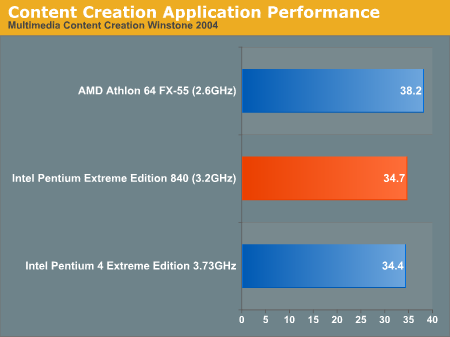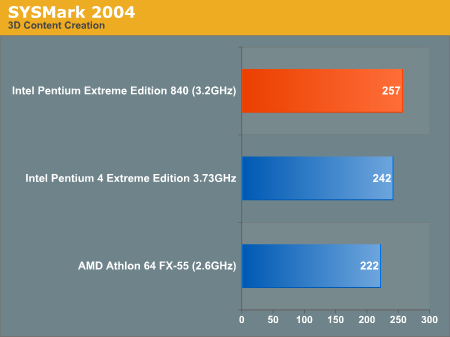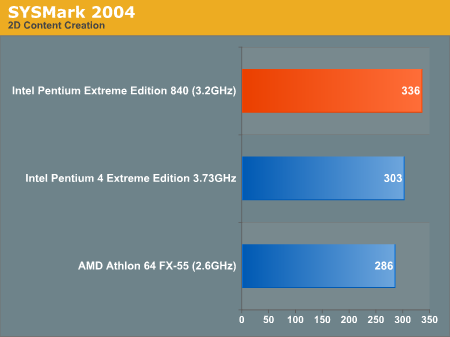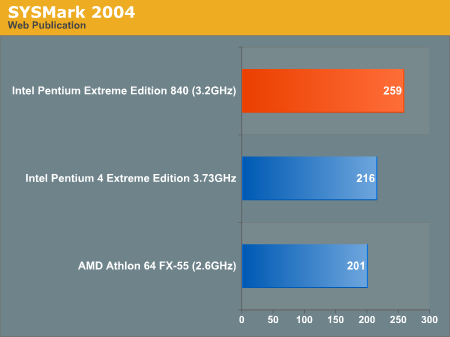Intel Dual Core Performance Preview Part I: First Encounter
by Anand Lal Shimpi on April 4, 2005 2:44 PM EST- Posted in
- CPUs
Multimedia Content Creation Performance
MCC Winstone 2004
Multimedia Content Creation Winstone 2004 tests the following applications in various usage scenarios:
- Adobe® Photoshop® 7.0.1
- Adobe® Premiere® 6.50
- Macromedia® Director MX 9.0
- Macromedia® Dreamweaver MX 6.1
- Microsoft® Windows MediaTM Encoder 9 Version 9.00.00.2980
- NewTek's LightWave® 3D 7.5b
- SteinbergTM WaveLabTM 4.0f
All chips were tested with Lightwave set to spawn 4 threads.

ICC SYSMark 2004
The first category that we will deal with is 3D Content Creation. The tests that make up this benchmark are described below:"The user renders a 3D model to a bitmap using 3ds max 5.1, while preparing web pages in Dreamweaver MX. Then, the user renders a 3D animation in a vector graphics format."

Next, we have 2D Content Creation performance:
"The user uses Premiere 6.5 to create a movie from several raw input movie cuts and sound cuts and starts exporting it. While waiting on this operation, the user imports the rendered image into Photoshop 7.01, modifies it and saves the results. Once the movie is assembled, the user edits it and creates special effects using After Effects 5.5."

The Internet Content Creation suite is rounded up with a Web Publishing performance test:
"The user extracts content from an archive using WinZip 8.1. Meanwhile, he uses Flash MX to open the exported 3D vector graphics file. He modifies it by including other pictures and optimizes it for faster animation. The final movie with the special effects is then compressed using Windows Media Encoder 9 series in a format that can be broadcast over broadband Internet. The web site is given the final touches in Dreamweaver MX and the system is scanned by VirusScan 7.0."

As soon as we throw in more content creation applications, some of which are multithreaded (e.g. 3ds max, Windows Media Encoder 9), the performance advantage of dual core is established. Here, we see that the dual core Pentium Extreme Edition running at 3.2GHz holds a 6% to 20% performance advantage over the higher clocked 3.73EE.
The performance advantages here are nice, but not the sort of order of magnitude in improvement that we'd been hearing about...










141 Comments
View All Comments
sharikou - Tuesday, April 5, 2005 - link
granted, this annand review was only part one, but hexus.net had done it much better in just one set of benches. From reading hexus.net's review, one can clearly see the advantages and limitations of INTEL's two-cpu-in-one-package device, basically, the intel chip are two cpus, so it can do two heavy duty things at the same time, but if you try to do 1 thing at a time, the new chip is slower, or if you do 3 things at the same time, the same slowness will occur.So your benchmarks are just designed to fit the new INTEL dual-CPU, doing two things, instead of one or three at the same time.
One suggestion I have is to do some comparison with a 2P Opteron workstation, we know AMD will release dual core Opterons soon, and using a SUN or BOXX opteron workstation, you can have 4 cores, it will be interesting to see how these 4 cores will perform.
We know INTEL won't be able to release 2P dual-chips until 2006. AMD forced INTEL to rush to dual chip.
Hans Maulwurf - Tuesday, April 5, 2005 - link
Well, I think I have to open my mind for dual core.But maybe you understand my fears about multitasking benchmarks. One could make many different benchmarks performing different on different platforms and chose one to put in his review. This looks a bit arbitrarily.
If someone benches games, for example, everybody will be curious if there is no Q3, D3 or UT. So the reader knows if a common(realistic) scenario is choosen for benching. Thsi is almost impossible for multitasking, I think.
I´m really interested in power consumption. Hexus writes there is only a slight increase in TDP, and no voltage drop. It will be interisting to see how this is possible as most parts of the CPU are doubled and I´ve not heard anything about different manufacturing techniques used for DC.
sharikou - Tuesday, April 5, 2005 - link
This is one of the worst reviews, worse than Toms' and worse than the AnndTech Athlon64 3500 vs Xeon 3.6GHZ review.1) What's the hardware setup?
2) why weren't there any game reviews if you are using $600 video cards?
3) why isn't there any power consumption figures?
INTEL's dual core isn't really dual-core, it's just two CPUs stick together, the two cpus share the same bus, without any logic in between. performance-wise, it should be the same as two xeon 3.2GHZ, and we know from Toms benchmark, a single Opteron 244 beats 2P xeon 3.2 in real applications.
lopri - Tuesday, April 5, 2005 - link
This is an impressive piece of work. No wonder AT is #1! Refreshingly different but more real-world-like benchmark.SignalPST - Tuesday, April 5, 2005 - link
Question:If you were to force a game to run using the second core, and only that game on the second core, and leaving the rest of the system overhead to the first core, wouldn't that provide a smoother and faster performance compared with the identical clocked single-core CPU?
JustAnAverageGuy - Tuesday, April 5, 2005 - link
Page 12."For this test, we used DVD Shrink, one of the simplest applications available to compress and re-encode a DVD to fit on a single 4.5GB disc."
Shouldn't that be 4.7GB?
Distributed Computing programs would be a good idea!
michael2k - Tuesday, April 5, 2005 - link
#51: Well, for people who would/SHOULD buy a dual core system, those are realistic scenarios. For those who game, or don't do those tasks, you won't see any performance benefits*#52: They were thinking, "The performance of the dual-core is more or less the same as the equivalent single-core CPU, so let's not be redundant and test dual-core CPUs where single-core CPUs are more cost effective**
*Performance in games will increase when they effectively do two things at once of roughly equal importance. For example:
ChessQuake, where one CPU deals with graphics, physics, sound, and AI, while the other CPU plays a game of chess
DVDooM, where one CPU draws the brightest and darkest blacks anyone has ever seen, while the other CPU is encoding it to DVD for posterity
As long as sound and light reflects geometry, you can't separate sound and rendering from interaction. Dual CPUs would be useful if you have two keyboards, two mice, and two displays for a two player game of DooM3 on a single computer.
**See the single core equivalent reviews. AnandTech as done them.
kmmatney - Tuesday, April 5, 2005 - link
misspell:Will Dual-Core work in Windows 2000? I don't see why not. I'd like to see a comparison between hyper-threading versus dual core in Win2K...I've heard that hyperthreading support is crippled in Win2K, but perhaps dual-core will work normally.
kmmatney - Tuesday, April 5, 2005 - link
Will Dual-Core work in Windows 2000? I don't see why not. I'd like to see a comparison between hyper-threading a dual core in Win2K...I've heard that hyperthreading support is crippled in Win2K, but perhaps dual-core will work normally.Natronomonas - Tuesday, April 5, 2005 - link
With two top-notch gaming CPUs (EE, FX), even if they do say the performance of the dual-core is more or less the same as the equivalent single-core CPU, it is disappointing not to see even a single gaming benchmark.What were they thinking??